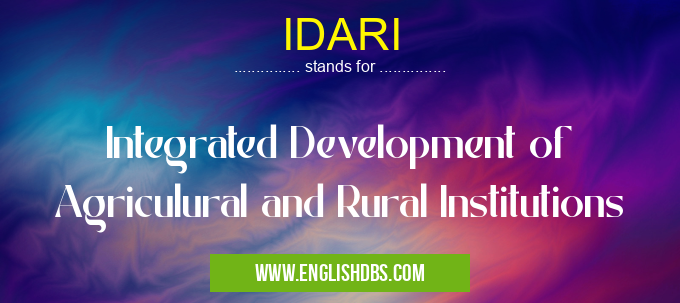What does IDARI mean in DEVELOPMENT
IDARI stands for Integrated Development of Agricultural and Rural Institutions. It is a comprehensive approach that aims to enhance agricultural productivity, promote rural development, and improve the overall well-being of rural communities. IDARI focuses on integrating various aspects of agricultural and rural development, including:

IDARI meaning in Development in Community
IDARI mostly used in an acronym Development in Category Community that means Integrated Development of Agriculural and Rural Institutions
Shorthand: IDARI,
Full Form: Integrated Development of Agriculural and Rural Institutions
For more information of "Integrated Development of Agriculural and Rural Institutions", see the section below.
» Community » Development
-
Agricultural research and extension: Conducting research and providing extension services to farmers to improve agricultural practices and productivity.
-
Rural infrastructure development: Investing in infrastructure such as roads, irrigation systems, and storage facilities to improve access to markets and enhance rural connectivity.
-
Capacity building and training: Providing training and capacity building programs for farmers, rural youth, and women to develop their skills and knowledge in agricultural and rural development.
-
Market development: Supporting the development of local markets and value chains to connect farmers with consumers and increase market opportunities.
-
Community-based initiatives: Promoting community-led initiatives to address local needs and empower rural communities.
Essential Questions and Answers on Integrated Development of Agriculural and Rural Institutions in "COMMUNITY»DEVELOPMENT"
What is the Integrated Development of Agricultural and Rural Institutions (IDARI)?
IDARI is a comprehensive approach to rural development, involving the integration of agricultural development and rural institutions. The approach focuses on improving the livelihoods of rural people and the sustainability of rural communities.
What are the key components of IDARI?
Key components of IDARI include:
- Agricultural development: Promoting sustainable farming practices, improving access to markets, and increasing agricultural productivity.
- Rural institutions: Strengthening local organizations, such as farmers' groups, cooperatives, and financial institutions, to support rural development initiatives.
- Infrastructure development: Investing in essential infrastructure, such as roads, electricity, and water supply, to improve access to markets and services.
- Community development: Empowering local communities to participate in the planning and implementation of development initiatives.
How does IDARI benefit rural communities?
IDARI benefits rural communities by:
- Improving agricultural productivity and incomes.
- Strengthening local institutions and fostering community participation.
- Enhancing access to infrastructure and services.
- Promoting sustainable development practices.
What are the challenges in implementing IDARI?
Challenges in implementing IDARI include:
- Limited access to financial resources.
- Lack of technical expertise and capacity building.
- Ensuring coordination and collaboration among stakeholders.
- Addressing cultural and social barriers.
How can the effectiveness of IDARI be improved?
The effectiveness of IDARI can be improved by:
- Prioritizing community participation and empowerment.
- Strengthening partnerships and collaboration among stakeholders.
- Investing in capacity building and knowledge sharing.
- Monitoring and evaluating progress regularly to adapt and refine the approach.
Final Words: IDARI is a holistic approach that recognizes the interconnectedness of agricultural and rural development. By integrating various aspects of these sectors, IDARI aims to create sustainable and prosperous rural communities while enhancing agricultural productivity and food security.
